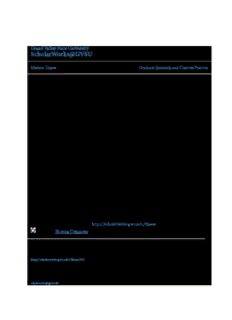
Humor and its Relationship to Cohesion of Work Group Members in the Acute Care Setting PDF
Preview Humor and its Relationship to Cohesion of Work Group Members in the Acute Care Setting
GGrraanndd VVaalllleeyy SSttaattee UUnniivveerrssiittyy SScchhoollaarrWWoorrkkss@@GGVVSSUU Masters Theses Graduate Research and Creative Practice 1997 HHuummoorr aanndd iittss RReellaattiioonnsshhiipp ttoo CCoohheessiioonn ooff WWoorrkk GGrroouupp MMeemmbbeerrss iinn tthhee AAccuuttee CCaarree SSeettttiinngg Marla J. Niedzwiecki Grand Valley State University Follow this and additional works at: https://scholarworks.gvsu.edu/theses Part of the Nursing Commons SScchhoollaarrWWoorrkkss CCiittaattiioonn Niedzwiecki, Marla J., "Humor and its Relationship to Cohesion of Work Group Members in the Acute Care Setting" (1997). Masters Theses. 441. https://scholarworks.gvsu.edu/theses/441 This Thesis is brought to you for free and open access by the Graduate Research and Creative Practice at ScholarWorks@GVSU. It has been accepted for inclusion in Masters Theses by an authorized administrator of ScholarWorks@GVSU. For more information, please contact [email protected]. HUMOR AND ITS RELATIONSHIP TO COHESION OF WORK GROUP MEMBERS IN THE ACUTE CARE SETTING By Marla J. Niedzwiecki A THESIS Submitted to Grand Valley State University in partial fulfillment of the requirements for the degree of MASTER OF SCIENCE IN NURSING Kirkhof School of Nursing 1997 Thesis Committee Members: Andrea C. Bostrom, Ph.D., R.N. Linda Nicholson Grinstead, Ph.D., R.N. Thomas Herzog, Ph.D. ABSTRACT HUMOR AND ITS RELATIONSHIP TO COHESION OF WORK GROUP MEMBERS IN THE ACUTE CARE SETTING By Maria J. Niedzwiecki The purpose of this study was to determine whether the relationship between the use of humor and cohesion of work groups. It was hypothesized that individuals with a high value and use of humor to cope would have a tendency to use humor with others. Additionally, groups with more members who value and use humor to cope would exhibit more group cohesion than groups consisting of members with minimal or no humor use. A descriptive correlational design was used. A convenience sample of hospital based staff nurses was studied. The participants completed three surveys measuring individuals’ use of humor to cope, value of humor and perception of group cohesion. Results indicated no significant correlations between individuals’ value and use of humor to cope and their assessment of group cohesion. There was no significant relationship between group rankings based on humor scores and that of group cohesion. Acknowledgments I would like to personally extend my sincere appreciation to those individuals that have contributed to the successful completion of this research project. A special ‘thank you’ is extended to Andrea Bostrom, Ph.D., RN, for her ongoing encouragement and support as my chairperson. I would also like to recognize Linda Nicholson Grinstead, Ph.D., RN and Thomas Herzog, Ph.D. for their ongoing support, time and sense of humor as members of my thesis committee. My deepest appreciation to Colleen Smith, my colleague for her words of encouragement. I would like to recognize my family, husband Tom, children Tieler and Taylor for enduring the long process of this project with a positive attitude. Without their patience this project would remain incomplete. My deepest gratitude to my parents for the words of encouragement, “I know you can do anything, I have no doubt.” And finally, I dedicate this thesis to my brother Spencer Kirk Clark (1968- 1986), as without life’s experiences, one cannot use or value humor. Table of Contents List of Tables...................................................................................................................vi List of Figures..............................................................................................................viii List of Appendices.........................................................................................................ix CHAPTER 1 INTRODUCTION.......................................................................................1 2 THEORY AND LITERATURE REVIEW...............................................4 Theoretical Framework...................................................................4 Roy’s adaptation model.......................................................4 Group theory.........................................................................8 Humor theory......................................................................11 Literature Review...........................................................................15 Research on humor in the workplace...............................15 Research on humor among nurses....................................19 Research on humor and groups.........................................20 Research on humor and the older adult..........................22 Research on group cohesion.............................................27 Definition of Terms........................................................................33 Hypotheses......................................................................................34 3 METHODOLOGY.....................................................................................35 Research Design.............................................................................35 Sample and Setting........................................................................36 Instruments......................................................................................38 Procedure........................................................................................42 IV CHAPTER 4 DATA ANALYSIS.....................................................................................44 Characteristics of Groups..............................................................44 Analysis of the Research Hypotheses.........................................51 Hypothesis 1.......................................................................51 Hypothesis 2 .......................................................................54 Additional Findings.......................................................................56 5 DISCUSSION AND IMPLICATIONS...................................................59 Discussion Related to Findings....................................................59 Discussion Related to Literature Review....................................61 Discussion Based on Theoretical Framework.............................63 Limitations and Recommendations..............................................65 Future Research.............................................................................67 Implications for Nursing...............................................................69 Conclusion......................................................................................70 APPENDICES 71 REFERENCES 79 List of Tables Table 1 Sample Distribution Based on Unit and Age..............................................44 2 Respondent’s Years of Employment as a Registered Nurse and on Current Unit......................................................................................45 3 Distribution of Respondents ’ Shift Assignment by Unit...........................46 4 Sample Distribution Based on Type of Position for Unit-based Groups........................................................................................46 5 Education of Respondents by Unit..............................................................47 6 Sample Distribution Based on Shift, Unit and Age...................................48 7 Respondents’ Years of Employment as a Registered Nurse and Employment on Current Unit...............................................................49 8 Sample Distribution Based on Type of Position by Study Group 50 9 Sample Distribution Based on Education of Study Groups.....................50 10 Correlations Among Humor Scores by Study Unit...................................52 11 Correlations Between Humor Scales and Group Cohesion.......................52 12 Correlations Among Humor Scores by Study Group................................53 13 Correlations Between Group Cohesion and Humor Scores by Study Group.............................................................................................54 14 Rank Ordering of Units Based on Mean Humor Scores and Mean Group Cohesion Score......................................................................55 vi Table 15 Rank Ordering of Study Groups Based on Mean Humor Scores and Mean Group Cohesion Score...................................................56 16 Correlations Between the Value of Humor and Subject Characteristics by Study Group.............................................................................................57 17 Correlations Between the Use of Humor to Cope and Subject.................. Characteristics Data by Study Group..........................................................58 18 Correlations Between Group Cohesion and Subject Characteristics by Study Group.............................................................................................58 VII List of Figures Figure 1 Model of Conceptual Framework................................................................15 VIII
Description: